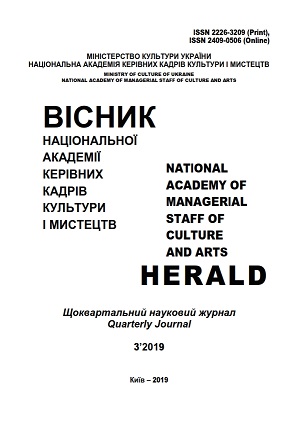Соцреалістичний канон та балетна критика середини 30-х рр. ХХ ст
Social Realism Canon and Ballet Criticism of the Middle of the 30s of the XX Century
Author(s): Alina Mykolayivna PidlypskaSubject(s): Theatre, Dance, Performing Arts, Cultural history, Aesthetics, Interwar Period (1920 - 1939), History of Art
Published by: Національна академія керівних кадрів культури і мистецтв
Keywords: criticism of ballet; social realism; aesthetics of social realism; ballet «Bright Stream»;
Summary/Abstract: Purpose of the article is to analyze the aesthetic canon of socialist realism and the principles of D. Lukacs and M. Lifshits in the projection on ballet criticism of the mid-30s. XX century (on the example of the ballet «Bright Stream» by Shostakovich-Lopuhov, 1936). Methodology. The use of methods for analyzing sources, concepts, comparing critical assessment approaches to the consideration of the ballet «Bright Stream» ensured an objective study. Scientific novelty. For the first time, the aesthetic principles of Lukach-Lifshic and the socialist-realist canon were extrapolated to the plane of ballet criticism of the mid-30s. XX century (on the example of the ballet «Bright Stream» by Shostakovich-Lopuhov, 1936). Conclusions. The requirements for observing the principles of socialist realism in art, the main of which were partisanship and nationality, were transmitted through critical articles. Opposing the simplified understanding of realism and its reduction to established stylistic canons, the founders of the journal «Literary critic» (Moscow, 1933–1940) D. Lukach, M. Lifshic, and others defended extra list criticism, since the artistic value of a work cannot be revealed exclusively through a prism style; substantiated the realism of art through proof of the reality of the content of any work of art; introduced the principles of friendly discussion and deep mutual respect of the critic and creator. The article «Ballet Falsehood» (February 6, 1936, criticism of the Shostakovich-Lopuhov ballet «Bright Stream» at the Bolshoi Theater, Moscow) played the role of a translator of the aesthetic requirements of the authorities for the art of ballet, a model of propaganda of mono-ideology through criticism. The article became a kind of warning to critics about the consequences of positive evaluations of ballets without correlating them with the canon of socialist realism.
Journal: Вісник Національної академії керівних кадрів культури і мистецтв
- Issue Year: 2019
- Issue No: 3
- Page Range: 347-352
- Page Count: 6
- Language: Ukrainian

